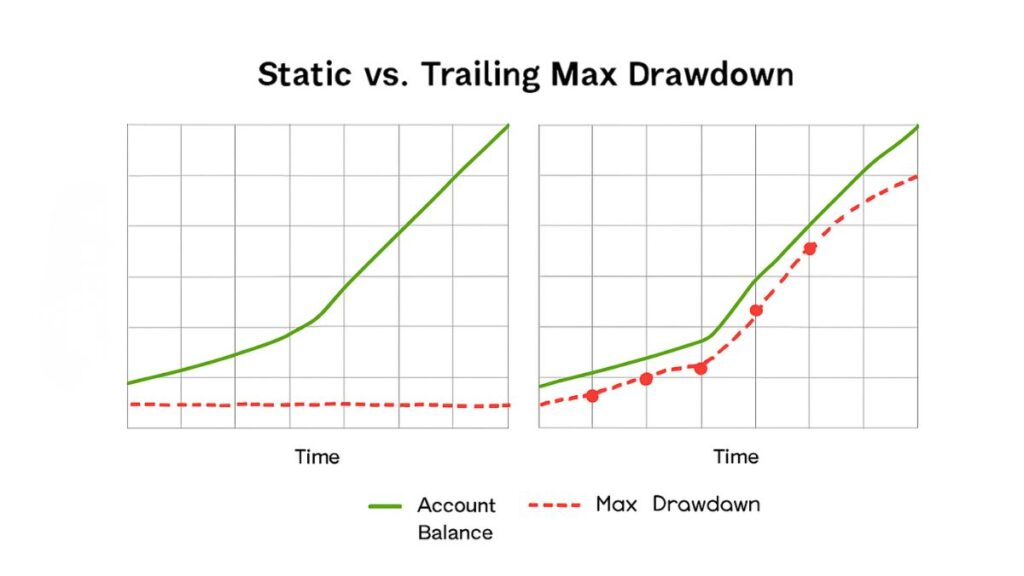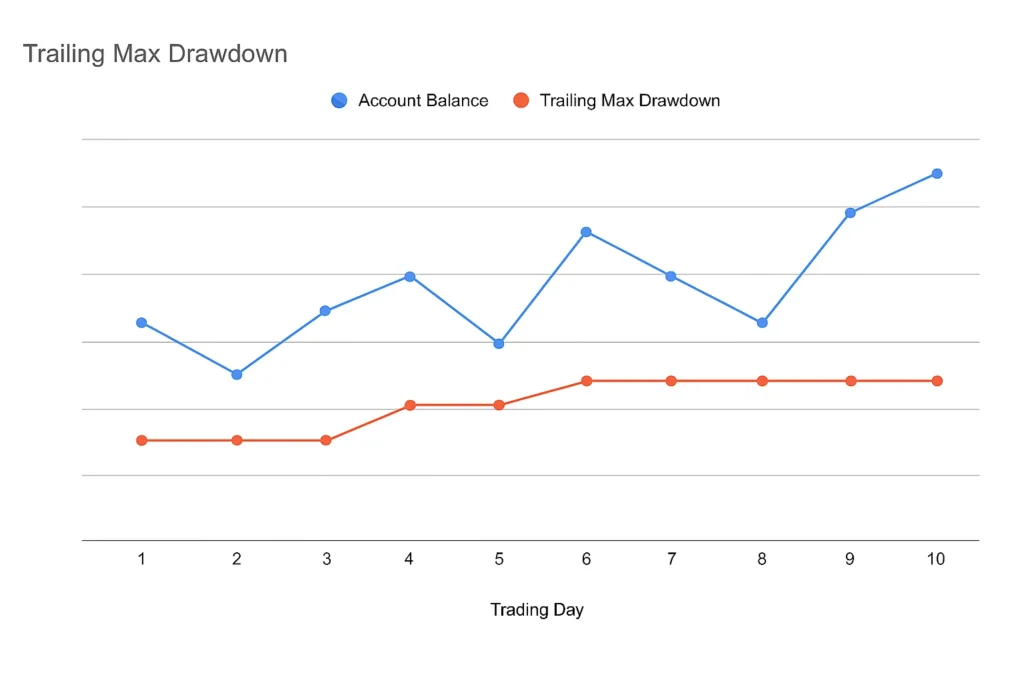Managing risk is one of the most important parts of becoming a profitable trader, and understanding drawdown types is a big part of that process. In proprietary trading challenges, the type of drawdown your prop firm uses can directly impact how you manage risk, take profits, and stay within limits.
The two most common types are static drawdown and trailing drawdown. They may sound similar, but they work very differently, and knowing how each one functions can make or break your challenge performance.
In this guide, you’ll learn:
- What static drawdown and trailing drawdown mean in prop firm challenges
- How each type affects your trading strategy and payout potential
- Why many traders prefer static drawdown because it’s simpler and more forgiving
- How trader-friendly prop firms that combine static drawdown and no consistency rules, such as MasterFunders, give traders more freedom and predictability
By the end, you’ll understand how drawdown type shapes your challenge experience and which setup best fits your trading style.

What Is Static vs Trailing Drawdown?
In prop firm challenges, drawdown limits define how much loss your account can experience before it breaches the rules. The two main types of drawdown systems are static drawdown and trailing drawdown, and understanding the difference between them is crucial for risk management.
Static Drawdown (Fixed or Absolute Drawdown)
A static drawdown is a fixed loss limit based on your starting balance. It never changes, even if your account grows.
For example:
You start with a $100,000 account and a 5 percent static drawdown. Your balance can never drop below $95,000, no matter how high your equity goes.
Advantages:
- Straightforward and easy to plan around
- The drawdown level stays constant throughout the challenge
- Profits you make do not reduce your breathing room
Drawbacks:
- It does not reward growth since the drawdown limit stays the same
- Even if your account grows significantly, your protection zone does not expand
Static drawdown is considered the most trader-friendly system because it provides predictability. Once you understand your loss limit, you can focus entirely on execution rather than monitoring shifting thresholds.
Trailing Drawdown (Dynamic or Moving Drawdown)

A trailing drawdown moves upward as your account equity increases. It is usually calculated as a percentage of your highest reached balance or equity.
Example:
You start with a $100,000 account and a 5 percent trailing drawdown.
If your balance grows to $110,000, the new drawdown threshold moves to $105,000.
If your account later falls below $105,000, even though you are still profitable overall, you breach the rule.
Benefits:
- Helps lock in profits by keeping traders from giving back too much after a winning streak
- Encourages tighter risk control as equity rises
Challenges:
- Creates pressure during normal market pullbacks
- Can punish strong strategies that have temporary drawdowns after large gains
- Requires constant attention to floating profit and open positions
Variants and Edge Cases
Not all trailing drawdowns function the same way. Some firms adjust limits only once daily, while others calculate them in real time.
- End-of-day trailing drawdown: The new limit is calculated only after the trading day ends, based on closed trades.
- Intraday or equity-based trailing drawdown: The limit moves instantly as unrealized profits appear or disappear, which can be very strict in volatile conditions.
- Hybrid models: Some firms blend both systems, starting with a trailing rule that eventually locks in and becomes static after a profit threshold is reached.
Understanding whether your prop firm uses static drawdown or trailing drawdown, and whether it is balance-based or equity-based, can make a major difference in how you size your trades and manage open risk.
Why Static Drawdown Is More Common and Why Trailing Drawdown Is Feared
Among prop traders, the difference between static and trailing drawdown is one of the most discussed topics. Static drawdown is viewed as fair and predictable, while trailing drawdown is often seen as stressful and restrictive.
Why Static Drawdown Wins in Popularity
- Simplicity: Static drawdown is easier to understand and monitor. The loss limit never moves, so traders can focus on performance instead of watching changing thresholds.
- Stability: Once you build profit, your buffer stays intact. The drawdown line does not rise with your equity, giving you room to manage open trades without fear of sudden breaches.
- Less stress: You are not constantly threatened by equity reversals or floating losses. This allows for better decision-making and emotional control during volatile sessions.
Because of these benefits, most traders see static drawdown as the more trader-friendly option. It lets them focus on execution rather than technical rule management.
Many traders describe trailing drawdown as “another way to fail you.” Once the drawdown line moves up, even a normal pullback can break the limit — even if the trader remains profitable overall.
Why Some Firms Use Trailing Drawdown
Some prop firms prefer trailing drawdown because it helps manage their capital exposure more tightly. As account equity grows, the firm’s risk also grows, and a moving drawdown helps limit large reversals.
Reasons firms choose trailing drawdown:
- Controls risk more strictly as capital increases
- Encourages consistency and discourages big losses after strong runs
- Protects firm capital from high volatility and sudden equity drops
However, this system can frustrate traders, especially those whose strategies depend on occasional large wins.
As one trader put it:
“Trailing drawdown eats your profits when you do well, forcing you to trade defensively.”
Another explained:
“I had a good day, but the next day a normal pullback hit me below the new limit. I failed even though I was still profitable overall.”
This tension between firm protection and trader freedom is what makes static drawdown vs trailing drawdown such a critical topic in prop trading communities.
Drawdown Types in 1-Step vs 2-Step Challenges
Prop firms use different evaluation models, and the type of drawdown they apply often depends on whether the challenge is one-step or two-step.
1-Step Challenges
In a 1-step challenge, traders only need to meet one set of profit and risk targets.
Because these challenges are meant to be straightforward, most firms use static drawdown. It simplifies risk management for both the trader and the firm and makes the challenge easier to understand.
Common traits of 1-step challenges:
- Simple profit and loss objectives
- Static drawdown limits that never move
- Fast evaluation and quicker payout timelines
2-Step Challenges
In a 2-step challenge, traders must complete two separate phases before getting funded. Some firms apply static drawdown in Phase 1 and then introduce trailing drawdown or stricter conditions in Phase 2.
This second phase is often designed to test risk discipline and consistency under more pressure.
Common traits of 2-step challenges:
- Phase 1: Static drawdown for initial evaluation
- Phase 2: Trailing or hybrid drawdown for consistency testing
- Funding after completion of both stages
To be clear, the drawdown type is a key factor that many traders overlook until it causes them to fail. Always review a prop firm’s rule page carefully to confirm whether it uses static or trailing drawdown, and whether that limit is based on balance or equity.
Who Wins and Who Struggles Under Each Drawdown Type?
The impact of drawdown type depends heavily on your trading strategy. Some traders benefit from the tighter structure of a trailing drawdown, while others perform better under the flexibility of a static drawdown. Understanding how your edge interacts with each system can help you choose the right prop firm model.
Scalpers and Day Traders
Scalpers and day traders rely on frequent, small trades throughout the session. A static drawdown gives them room to manage normal fluctuations and occasional spikes without worrying that a profitable day will tighten future limits.
Under a trailing drawdown, a big winning day can raise the loss limit. Even a normal pullback or slow session afterward might push the account below the new threshold and trigger a breach. For fast, high-frequency styles, this can feel restrictive and unpredictable.
Trend Followers
Trend-following traders aim to capture large market moves that might only happen a few times per month. With static drawdown, they can hold positions longer and allow profits to develop without fear of their drawdown limit rising.
In a trailing drawdown setup, the situation is different. When the trade moves strongly in their favor, the drawdown limit adjusts upward. If the market later retraces before the trader exits, they could breach the limit even while finishing the month profitable.
Algo and Quantitative Traders
Algorithmic and quantitative traders typically work with systems that generate a consistent edge but include occasional large wins. Static drawdown is safer for these setups because it allows natural statistical variance without penalty.
With trailing drawdown, these systems can be punished for outlier performance. When an algorithm catches a big move, the trailing limit may shift higher, and a normal equity retracement afterward could violate the rule. This undermines how many algos are designed to perform over time.
News and Event Traders
News and event traders thrive on volatility. They target big moves during high-impact events like NFP, CPI, or FOMC announcements. A static drawdown gives them flexibility to capture sudden price surges without worrying that their limits will tighten afterward.
Under a trailing drawdown, this strategy becomes more dangerous. A large winning day can move the loss limit higher, and any quick retracement or consolidation can lead to an unexpected breach even though the trader remains net positive.
In short, traders whose edges depend on variability, asymmetry, or occasional large gains generally perform better in environments with static drawdown and no consistency rules. This setup allows traders to take advantage of strong opportunities without being punished by rule mechanics that change as their equity rises.
Trade with Confidence: Static Drawdown and No Consistency Rules Are Trader-Friendly
Many traders agree that the most balanced and fair evaluation structure is a static drawdown combined with no consistency rules. This setup gives traders the freedom to trade naturally without feeling constrained by changing limits or hidden conditions.
Here is why this model is considered the most trader-friendly:
- Your risk is fixed and predictable: With a static drawdown, you know your exact maximum loss from the start. It never moves, even if your balance grows.
- Your profit distribution is not penalized: No consistency rule means your profits can come from any number of days — one strong day or several smaller ones — without affecting your eligibility to pass.
- You can trade your edge with confidence: When you are not worried about prop firm rules changing mid-challenge, you can focus on proper execution, risk management, and strategy refinement.
MasterFunders follows this structure by offering static drawdown and no consistency rules across their challenges. This approach allows traders to trade freely and fairly, knowing that only their performance — not arbitrary restrictions — determines success.
Prop Firms Without Trailing Drawdown
If you are looking for prop firms without trailing drawdown, focus on companies that use static drawdown models. These firms set a fixed maximum loss limit that does not tighten as your account grows. It gives traders more control and less pressure during evaluations.
Firms that offer static drawdown are often described as trader-friendly because they prioritize transparency and simplicity. They let traders manage their positions without worrying about a moving equity limit or sudden breaches caused by normal pullbacks.
MasterFunders is one of the firms in this category, using static drawdown in all challenges. By removing trailing drawdown and consistency rules, they make the trading environment more predictable and fair for all types of traders.
Frequently Asked Questions
What is the difference between static and trailing drawdown?
A static drawdown is a fixed loss limit that never changes from your starting balance. A trailing drawdown moves upward as your account equity increases, tightening your loss limit after profitable trades. Static drawdown is simpler and more forgiving, while trailing drawdown is stricter and moves dynamically with performance.
Why do some prop firms use trailing drawdown?
Some firms use trailing drawdown to control risk as traders grow their accounts. It ensures that traders cannot lose too much of their gains after reaching higher equity levels. However, many traders find it restrictive because even small reversals can trigger violations after strong runs.
Which drawdown type is better for most traders?
Most traders prefer static drawdown because it is stable, predictable, and easier to plan around. It lets traders manage risk consistently without worrying that a profitable day will raise the loss limit.
Are static drawdown firms more trader-friendly?
Yes. Firms that use static drawdown and avoid unnecessary rules like the consistency rule are generally considered more trader-friendly. These firms let you focus on trading performance rather than navigating technical rule changes.
Does MasterFunders use trailing or static drawdown?
MasterFunders uses static drawdown on all challenges. They do not apply a consistency rule, meaning your results are evaluated only by your profit target and drawdown limits, not by how profits are distributed across days.
What is the best setup for passing prop firm challenges?
For most traders, the best setup is static drawdown with no consistency rule. It provides fairness, transparency, and flexibility, allowing you to trade your own way without unnecessary restrictions.

